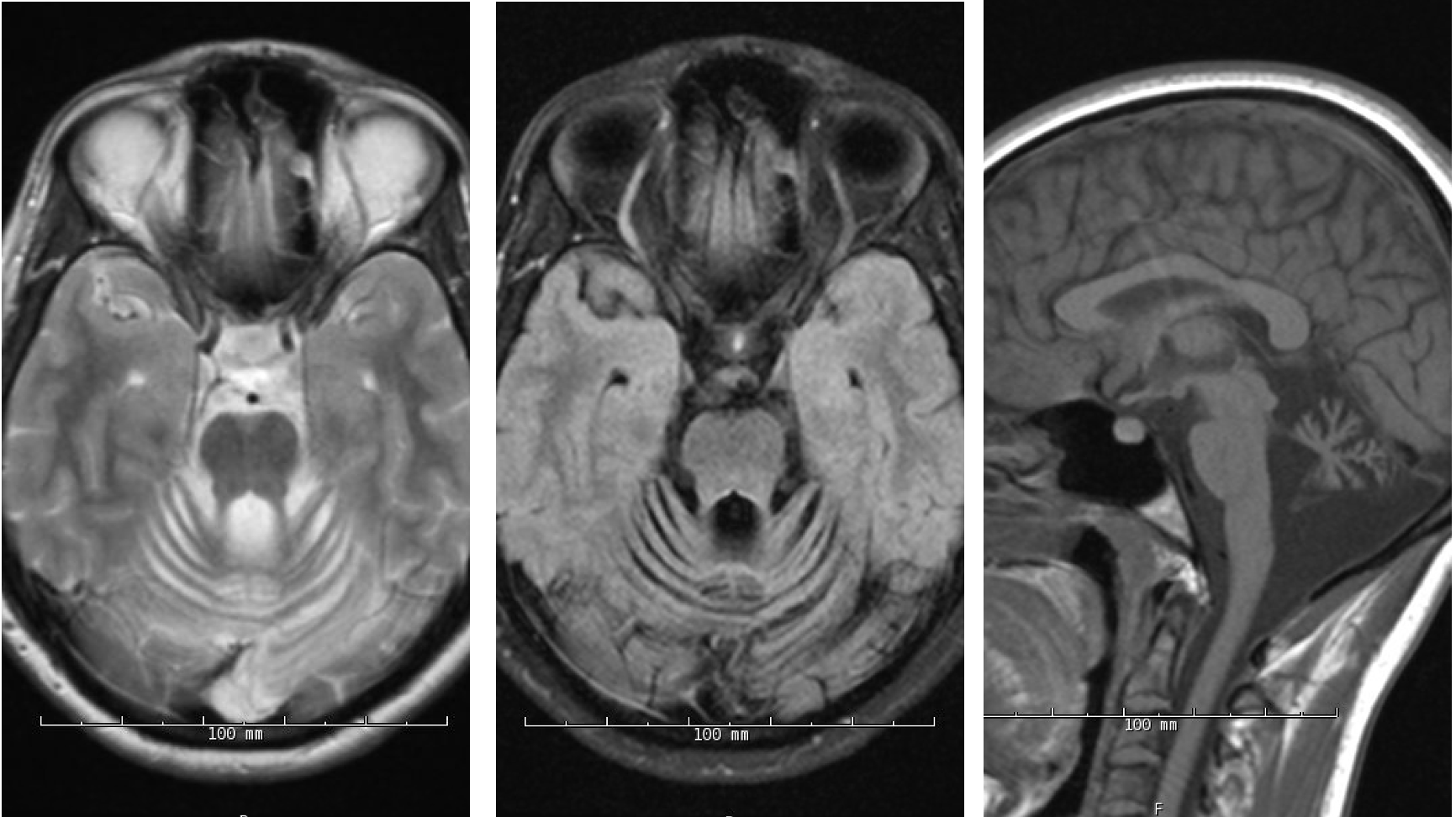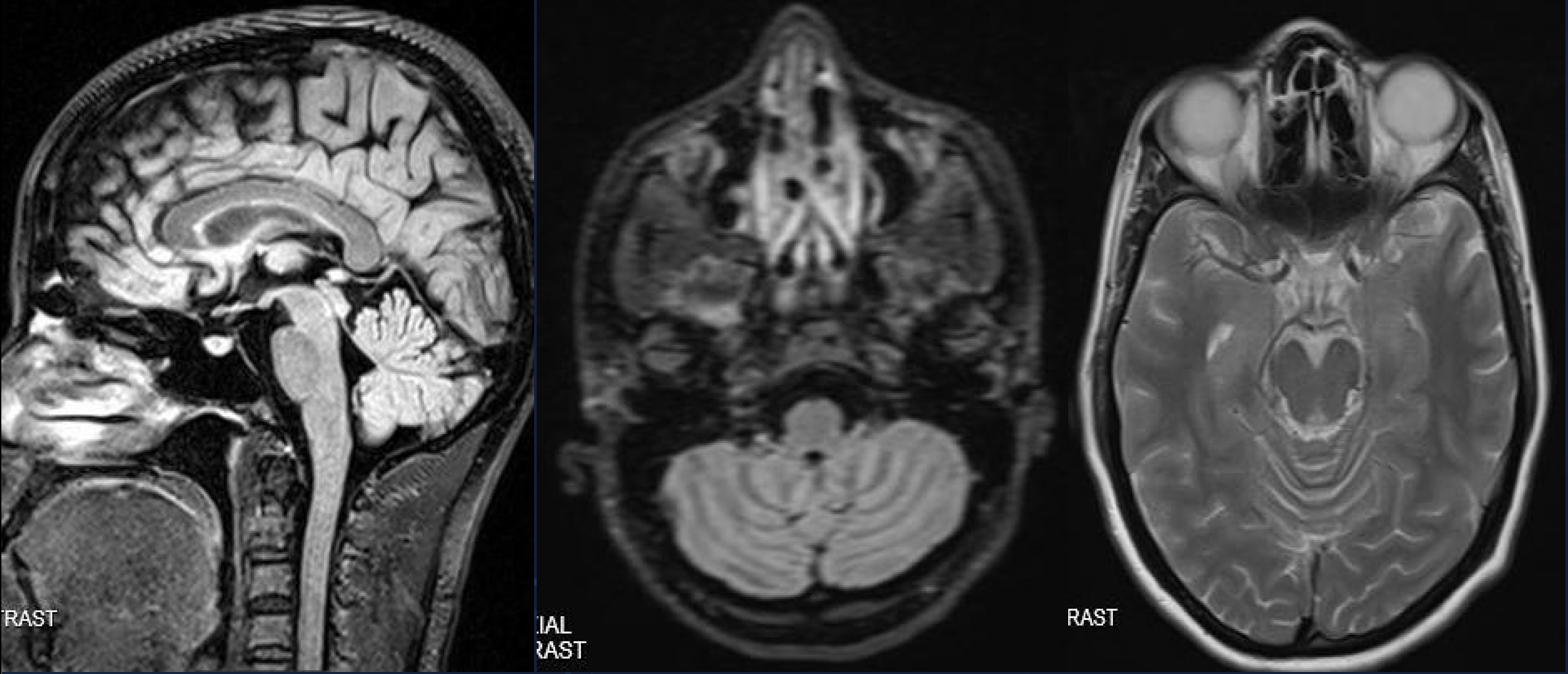Category: Rare Genetic and Metabolic Diseases
Objective: To report clinical phenotypes of 2 siblings with symptoms of Juvenile-onset D-bifunctional protein (DBP) deficiency.
Background: HSD17B4 gene codes for DBP, a peroxisomal protein with a role in β-oxidation of fatty acids. Mutations inHSD17B4 cause DBP deficiency, commonly presenting in infancy with hypotonia, seizures, and dysmorphic facies. However, a subset of people presents in adolescence. We present 2 sisters with symptoms consistent with Juvenile DBP deficiency.
Method: Case 1: 33-year-old proband presents with dysarthria, hearing loss, gait instability since age 15. She also reports hyperlax joints, neuropsychiatric symptoms (anxiety, panic attacks), and oligomenorrhea. Exam shows dysarthria, gait and appendicular ataxia, sensory neuropathy. MRI Brain shows cerebellar atrophy [Fig1]. Vitamin B1, B12, E, folate, alpha-feto protein, FSH/LH/estrogen, VLCFA normal. Test for repeat expansions is negative. Ataxia Xpanded® Panelwas positive for 2 heterozygous variants of uncertain significance in HSD17B4 gene c.595 C>T p.(R199W) and c.1732 T>C p.(W578R).
Case 2: 40-year-old woman (proband’s sister) presents with gait instability since age 9 and dyspnea on exertion for 17 years. Pulmonary functions show restrictive patterns. Exam shows gait and appendicular ataxia, neuropathy, mild hypotonia, hip flexion weakness. MRI Brain shows cerebellar atrophy [Fig2]. She was positive for one of the mutations c.1732 T>C p.(W578R).
There is a family history of consanguinity in the unaffected parents (deceased). 2 siblings and multiple cousins with same but milder phenotypes are in Pakistan and not examined.
Results: NA
Conclusion: Juvenile DBP deficiency presents with ataxia, cerebellar atrophy, hearing loss, neuropathy, and ovarian dysgenesis. Amor, David et.al in 2016 reported a summary of affected individuals and our patients share several features. However, only one case with the same mutation has been reported in an infant by Kasula LR et.al (2023). Hyperlax joints and neuropsychiatric symptoms have not been previously reported. This report expands the clinical phenotype of Juvenile DBP deficiency. Testing the sister confirmed compound heterozygosity in the proband. But we acknowledge the diagnostic limitations in the absence of a molecular diagnosis. Whole exome sequencing may be a reasonable next step for better phenotypic-genotypic characterization of this family and may offer new insights into this rare disorder.
Proband – Severe cerebellar atrophy on MRI
Mild cerebellar atrophy on MRI
References: Amor DJ, Marsh AP, Storey E, Tankard R, Gillies G, Delatycki MB, Pope K, Bromhead C, Leventer RJ, Bahlo M, Lockhart PJ. Heterozygous mutations in HSD17B4 cause juvenile peroxisomal D-bifunctional protein deficiency. Neurol Genet. 2016 Oct 18;2(6):e114. doi: 10.1212/NXG.0000000000000114. PMID: 27790638; PMCID: PMC5070413.
Kasula LR et al (2023). D-Bifunctional Protein Deficiency: In a Neonate, Are We Missing – A Case Series. Asian J Pediatr Res. 13(3):67-72
J. Konkoľová, R. Petrovič, J. Chandoga, M. Repiský, H. Zelinková, J. Kršiaková, M. Kolníková, D. Kantarská, S. Šutovský, D. Böhmer. Peroxisomal D-bifunctional protein deficiency: First case reports from Slovakia,Gene. Volume 568, Issue 1, 2015, Pages 61-68, ISSN 0378-1119, https://doi.org/10.1016/j.gene.2015.05.020.
Landau YE, Heimer G, Barel O, Shalva N, Marek-Yagel D, Veber A, Javasky E, Shilon A, Nissenkorn A, Ben-Zeev B, Anikster Y. Four patients with D-bifunctional protein (DBP) deficiency: Expanding the phenotypic spectrum of a highly variable disease. Mol Genet Metab Rep. 2020 Aug 15;25:100631. doi: 10.1016/j.ymgmr.2020.100631. PMID: 32904102; PMCID: PMC7451421.
Gabriele Möller, et al,. Characterization of the HSD17B4 gene: d-specific multifunctional protein 2/17β-hydroxysteroid dehydrogenase IV, The Journal of Steroid Biochemistry and Molecular Biology, Volume 69, Issues 1–6, 1999,. Pages 441-446, ISSN 0960-0760, https://doi.org/10.1016/S0960-0760(99)00066-7
Cheng, Hao-Ling & Shao, Ya-Ru & Dong, Yi & Dong, Hai-Lin & Yang, Lu & Ma, Yin & Shen, Ying & Wu, Zhi-Ying. (2021). Genetic spectrum and clinical features in a cohort of Chinese patients with autosomal recessive cerebellar ataxias. Translational Neurodegeneration. 10. 10.1186/s40035-021-00264-z.
To cite this abstract in AMA style:
M. Roy, C. Goetz, M. Rosenbaum. Juvenile DBP Deficiency – Case series [abstract]. Mov Disord. 2024; 39 (suppl 1). https://www.mdsabstracts.org/abstract/juvenile-dbp-deficiency-case-series/. Accessed April 20, 2025.« Back to 2024 International Congress
MDS Abstracts - https://www.mdsabstracts.org/abstract/juvenile-dbp-deficiency-case-series/


